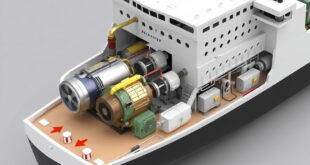Military Electrification: The Silent Revolution in Combat Vehicles One-Liner: How electric and hybrid military vehicles are redefining stealth, efficiency, and battlefield power. The modern battlefield is evolving, and so is military technology. As armed forces worldwide seek to enhance mobility, reduce logistical burdens, and improve sustainability, electric and hybrid land …
Read More »The Future of UAV Propulsion Systems: Advances, Challenges, and Innovations
The Future of UAV Propulsion: From Solar Flyers to Supersonic Swarms Breakthrough propulsion systems are setting the stage for faster, cleaner, and smarter drones. Introduction Unmanned Aerial Vehicles (UAVs) have transformed military, commercial, and scientific domains, with their propulsion systems being a key factor in determining endurance, efficiency, and mission …
Read More »The Hyperloop Revolution: Market Surge, Technological Leaps, and the Global Push for Ultra-High-Speed Transport (2025 Update)
The Hyperloop Revolution: Market Surge, Technological Leaps, and the Global Race for Ultra-High-Speed Transport Hyperloop technology is moving from vision to reality, promising near-supersonic travel, zero emissions, and a global transformation in how we connect cities. The dream of whisking between cities at near-supersonic speeds through low-pressure tubes is no …
Read More »Carbon Capture, Utilization, and Storage (CCUS): Bridging the Gap to a Net-Zero Future
Carbon Capture: Powering Net-Zero with Innovation and Industrial Transformation From steel plants to shipping lanes, CCUS is quietly reshaping our climate future—one captured molecule at a time. As the world accelerates its fight against climate change, Carbon Capture, Utilization, and Storage (CCUS) is emerging as a critical lever in the …
Read More »Wearable Batteries: Powering the Future of Soldiers and Smart Devices
Wearable Batteries: The Power Behind Smart Tech and Modern Soldiers Discover how next-gen wearable batteries are revolutionizing defense, health, and everyday tech with smarter, lighter, and longer-lasting power. In the age of smart technology, wearable devices have become an essential part of our daily lives. From fitness trackers and smartwatches …
Read More »Dual-Fuel Electric+ (DFE+) and Dual-Fuel Diesel Electric (DFE) Propulsion Systems: The Future of Maritime and Industrial Efficiency
DFE and DFE+: Powering the Future of Clean, Smart Marine Propulsion From LNG to batteries, dual-fuel systems are driving the global shift to cleaner, more flexible energy on sea and land. The global push toward cleaner and more efficient energy solutions has driven significant advancements in hybrid propulsion technology. Dual-Fuel …
Read More »The Future is Electric: Exploring the Expanding Market of Electric Propulsion Satellites
Electric Propulsion Satellites: The Silent Revolution Powering the Future of Space Discover how electric propulsion is transforming satellites—from commercial missions to military surveillance. The development of electric propulsion systems for small spacecraft has revolutionized our capabilities, from deep space exploration to covert spy missions. This technology offers a promising solution …
Read More »Underwater Fibre Laser-Induced Plasma Detonation Wave Propulsion: A New Era for Submarine Technology
Laser-Driven Submarines: Underwater Fibre Plasma Propulsion Redefines Naval Speed and Stealth The world of underwater propulsion is about to take a leap forward, thanks to an exciting breakthrough in the field of laser technology. While submarines and other underwater vessels have traditionally relied on mechanical propellers to generate thrust, new …
Read More »Future Smart Energy Buildings: Requirements and Technologies
Future Smart Energy Buildings: The Tech-Powered Revolution in Urban Sustainability Discover how AI, IoT, and renewable energy are reshaping tomorrow’s buildings into smart, sustainable ecosystems. Introduction As urbanization accelerates and climate concerns intensify, the demand for energy-efficient, technologically advanced buildings has never been greater. Future smart energy buildings are poised …
Read More »Pioneering the Future of Space with Nuclear Propulsion for Space Servicing, Mobility, and Logistics (SAML) Missions
Nuclear Propulsion: Powering the Future of Space Servicing, Mobility, and Logistics Unlocking the next frontier in orbit and beyond—nuclear propulsion is redefining how we move, service, and explore in space. As humanity ventures deeper into the cosmos, the need for more advanced propulsion systems to support Space Servicing, Mobility, and …
Read More » International Defense Security & Technology Your trusted Source for News, Research and Analysis
International Defense Security & Technology Your trusted Source for News, Research and Analysis









